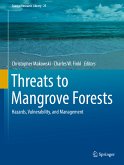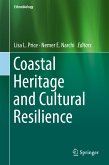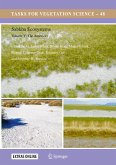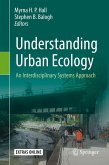Sabkha Ecosystems (eBook, PDF)
Volume VI: Asia/Pacific
Redaktion: Gul, Bilquees; Hameed, Abdul; Clüsener-Godt, Miguel; Khan, M. Ajmal; Böer, Benno
112,95 €
112,95 €
inkl. MwSt.
Sofort per Download lieferbar

56 °P sammeln
112,95 €
Als Download kaufen

112,95 €
inkl. MwSt.
Sofort per Download lieferbar

56 °P sammeln
Jetzt verschenken
Alle Infos zum eBook verschenken
112,95 €
inkl. MwSt.
Sofort per Download lieferbar
Alle Infos zum eBook verschenken

56 °P sammeln
Sabkha Ecosystems (eBook, PDF)
Volume VI: Asia/Pacific
Redaktion: Gul, Bilquees; Hameed, Abdul; Clüsener-Godt, Miguel; Khan, M. Ajmal; Böer, Benno
- Format: PDF
- Merkliste
- Auf die Merkliste
- Bewerten Bewerten
- Teilen
- Produkt teilen
- Produkterinnerung
- Produkterinnerung

Bitte loggen Sie sich zunächst in Ihr Kundenkonto ein oder registrieren Sie sich bei
bücher.de, um das eBook-Abo tolino select nutzen zu können.
Hier können Sie sich einloggen
Hier können Sie sich einloggen
Sie sind bereits eingeloggt. Klicken Sie auf 2. tolino select Abo, um fortzufahren.

Bitte loggen Sie sich zunächst in Ihr Kundenkonto ein oder registrieren Sie sich bei bücher.de, um das eBook-Abo tolino select nutzen zu können.
This book is the sixth and final volume in the Tasks for Vegetation Science book series, and it concludes the most comprehensive scientific documentation dealing with hypersaline ecosystems of the world.
- Geräte: PC
- ohne Kopierschutz
- eBook Hilfe
- Größe: 29.31MB
Andere Kunden interessierten sich auch für
![Brazilian Estuaries (eBook, PDF) Brazilian Estuaries (eBook, PDF)]() Brazilian Estuaries (eBook, PDF)72,95 €
Brazilian Estuaries (eBook, PDF)72,95 €![Threats to Mangrove Forests (eBook, PDF) Threats to Mangrove Forests (eBook, PDF)]() Threats to Mangrove Forests (eBook, PDF)136,95 €
Threats to Mangrove Forests (eBook, PDF)136,95 €![Coastal Heritage and Cultural Resilience (eBook, PDF) Coastal Heritage and Cultural Resilience (eBook, PDF)]() Coastal Heritage and Cultural Resilience (eBook, PDF)112,95 €
Coastal Heritage and Cultural Resilience (eBook, PDF)112,95 €![Advances in Marine Vertebrate Research in Latin America (eBook, PDF) Advances in Marine Vertebrate Research in Latin America (eBook, PDF)]() Advances in Marine Vertebrate Research in Latin America (eBook, PDF)112,95 €
Advances in Marine Vertebrate Research in Latin America (eBook, PDF)112,95 €![Natural Disturbances and Historic Range of Variation (eBook, PDF) Natural Disturbances and Historic Range of Variation (eBook, PDF)]() Natural Disturbances and Historic Range of Variation (eBook, PDF)72,95 €
Natural Disturbances and Historic Range of Variation (eBook, PDF)72,95 €![Sabkha Ecosystems (eBook, PDF) Sabkha Ecosystems (eBook, PDF)]() Sabkha Ecosystems (eBook, PDF)112,95 €
Sabkha Ecosystems (eBook, PDF)112,95 €![Understanding Urban Ecology (eBook, PDF) Understanding Urban Ecology (eBook, PDF)]() Understanding Urban Ecology (eBook, PDF)72,95 €
Understanding Urban Ecology (eBook, PDF)72,95 €-
-
-
This book is the sixth and final volume in the Tasks for Vegetation Science book series, and it concludes the most comprehensive scientific documentation dealing with hypersaline ecosystems of the world.
Dieser Download kann aus rechtlichen Gründen nur mit Rechnungsadresse in A, B, BG, CY, CZ, D, DK, EW, E, FIN, F, GR, HR, H, IRL, I, LT, L, LR, M, NL, PL, P, R, S, SLO, SK ausgeliefert werden.
Produktdetails
- Produktdetails
- Verlag: Springer Nature Switzerland
- Seitenzahl: 511
- Erscheinungstermin: 5. August 2019
- Englisch
- ISBN-13: 9783030044176
- Artikelnr.: 57625741
- Verlag: Springer Nature Switzerland
- Seitenzahl: 511
- Erscheinungstermin: 5. August 2019
- Englisch
- ISBN-13: 9783030044176
- Artikelnr.: 57625741
- Herstellerkennzeichnung Die Herstellerinformationen sind derzeit nicht verfügbar.
1. Halophyte Research, Conservation & Development - The role of UNESCO Biosphere Reserves in Asia/Pacific.- 2. Evidence for the role of salinity and alkalinity in plant diversification in Australia.- 3. Aspects of the Abu Dhabi Sabkha.- 4.Comparative seed germination ecology of sabkha and playa halophytes of Pakistan.- 5. Plants of sabkha ecosystems of the Arabian Peninsula.- 6. Desert Halophytes: Alleviating the Pressure on the Scarce Resources of Arable Soil and Fresh Water.- 7. Drone-based vegetation assessment in arid ecosystems.- 8.Salt-induced Changes in Growth and Damage-avoidance-mechanisms of Hydroponically Grown Chinese Kale (Brassica alboglabra L.).- 9. Growth dynamic of Tamarix chinensis plantations in coastal heavy saline land and its ecological effect.- 10. Mechanisms of ion transport in halophytes, from roots to leaves.- 11. Interpretation of Holocene Carbonate-Evaporites of Coastal and Inland Sabkhas of Abu Dhabi (United Arab Emirates) Using Landsat Satellite Images andField Survey.- 12. Climate change impacts on salt marsh vegetation ecophysiology.- 13. Morphology and betalain characterization of 'ice plants' (Aizoaceae) from the coast of Wellington, New Zealand.- 14. Salt-tolerance and potential uses for saline agriculture of halophytes from the Poaceae.- 15. Phenotyping through Infra-Red Thermography in stress environment.- 16. The Mangroves of Myanmar.- 17. Potentially domesticable chenopodiacea halophytes of Iran.- 18. Plant Growth Promoting Bacteria associated to the halophyte Suaeda maritima (L.) in Abbas, Iran.- 19. Quinoa: A new crop for harsh environments.- 20. Difference in antioxidant defense system between the halophytes and glycophytes to overcome the salinity stress.- 21. Diversity and distribution of salt-tolerant plants of the United Arab Emirates: perspectives for sustainable utilization and future research.- 22. Framework for rapid evaluation of a mangrove restoration site: A case study from Indian Sundarban.- 23. Mangrove Biogeography of the Indo-Pacific.- 24. Short Communications - Suggestions for Improving Science Communication for Halophyte Conservation, Research and Development.- 25. Ligno-cellulosic biomass from sabkha native vegetation: a new potential source for fiber-based bioenergy production.- 26. The Floristical, Ecological and Syntaxonomical Characteristics of Salt Marshes and Salt Steppes of Turkey.- 27. Temporal variations in water and ion relations of coastal halophytes.- 28. Mangrove Cover, Biodiversity and Carbon Storage of Mangrove Forests in Thailand.- 29. Pollen morphology of the genus Tamarix in Israel.- 30. Species distribution in different ecological zones and conservation strategy of Halophytes of Sundarbans Mangrove Forest of Bangladesh.- 31. Cash Crop Holophytes of China.- 32. Sabkha Ecosystems Vol VI - Asia Pacific: Summarizing the Story.
1. Halophyte Research, Conservation & Development - The role of UNESCO Biosphere Reserves in Asia/Pacific.- 2. Evidence for the role of salinity and alkalinity in plant diversification in Australia.- 3. Aspects of the Abu Dhabi Sabkha.- 4.Comparative seed germination ecology of sabkha and playa halophytes of Pakistan.- 5. Plants of sabkha ecosystems of the Arabian Peninsula.- 6. Desert Halophytes: Alleviating the Pressure on the Scarce Resources of Arable Soil and Fresh Water.- 7. Drone-based vegetation assessment in arid ecosystems.- 8.Salt-induced Changes in Growth and Damage-avoidance-mechanisms of Hydroponically Grown Chinese Kale (Brassica alboglabra L.).- 9. Growth dynamic of Tamarix chinensis plantations in coastal heavy saline land and its ecological effect.- 10. Mechanisms of ion transport in halophytes, from roots to leaves.- 11. Interpretation of Holocene Carbonate-Evaporites of Coastal and Inland Sabkhas of Abu Dhabi (United Arab Emirates) Using Landsat Satellite Images andField Survey.- 12. Climate change impacts on salt marsh vegetation ecophysiology.- 13. Morphology and betalain characterization of 'ice plants' (Aizoaceae) from the coast of Wellington, New Zealand.- 14. Salt-tolerance and potential uses for saline agriculture of halophytes from the Poaceae.- 15. Phenotyping through Infra-Red Thermography in stress environment.- 16. The Mangroves of Myanmar.- 17. Potentially domesticable chenopodiacea halophytes of Iran.- 18. Plant Growth Promoting Bacteria associated to the halophyte Suaeda maritima (L.) in Abbas, Iran.- 19. Quinoa: A new crop for harsh environments.- 20. Difference in antioxidant defense system between the halophytes and glycophytes to overcome the salinity stress.- 21. Diversity and distribution of salt-tolerant plants of the United Arab Emirates: perspectives for sustainable utilization and future research.- 22. Framework for rapid evaluation of a mangrove restoration site: A case study from Indian Sundarban.- 23. Mangrove Biogeography of the Indo-Pacific.- 24. Short Communications - Suggestions for Improving Science Communication for Halophyte Conservation, Research and Development.- 25. Ligno-cellulosic biomass from sabkha native vegetation: a new potential source for fiber-based bioenergy production.- 26. The Floristical, Ecological and Syntaxonomical Characteristics of Salt Marshes and Salt Steppes of Turkey.- 27. Temporal variations in water and ion relations of coastal halophytes.- 28. Mangrove Cover, Biodiversity and Carbon Storage of Mangrove Forests in Thailand.- 29. Pollen morphology of the genus Tamarix in Israel.- 30. Species distribution in different ecological zones and conservation strategy of Halophytes of Sundarbans Mangrove Forest of Bangladesh.- 31. Cash Crop Holophytes of China.- 32. Sabkha Ecosystems Vol VI - Asia Pacific: Summarizing the Story.







